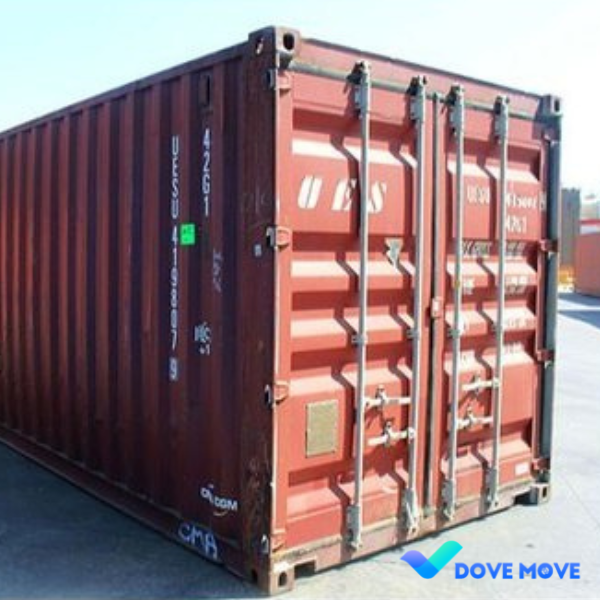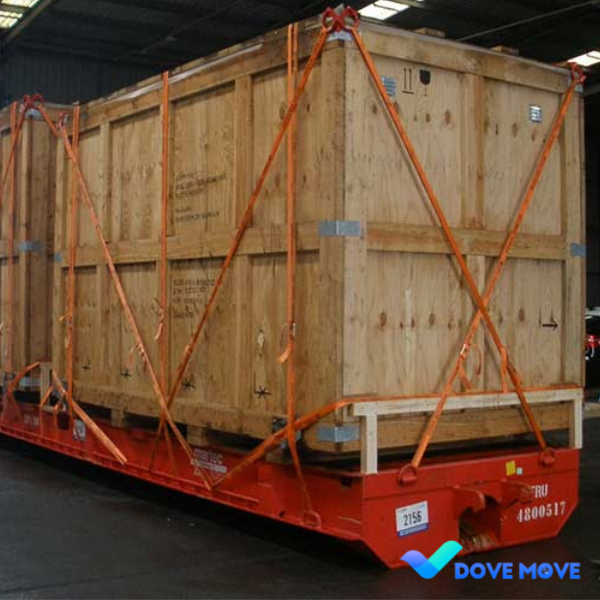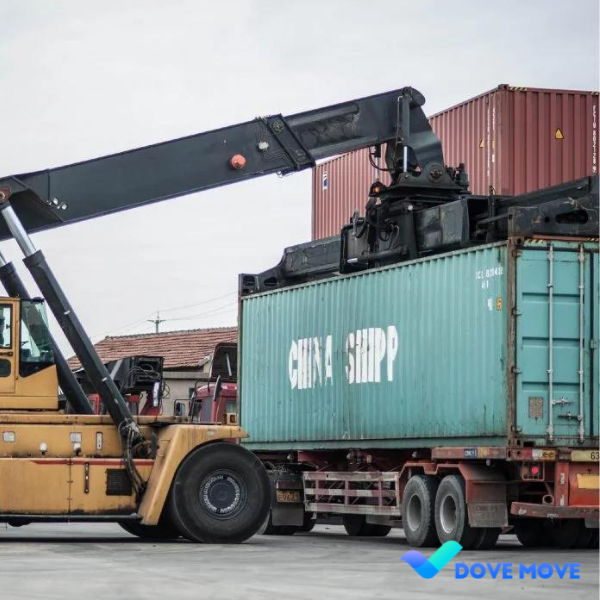Home » Our Services » Shipping Services » FCL (Full Container Load)
FCL Shipment from China
with the best shipping rates from China
Dove Move Provides the best shipping services at very affordable rates. Key points of our FCL freight forwarding from China are as follow:
- Dove Move ensures reliable Full Container Load (FCL) shipments from China, offering a trustworthy and consistent service.
- Benefit from cost-effective solutions with Dove Move, as they provide competitive pricing for FCL shipments, optimizing your transportation expenses.
- Leveraging their expertise in navigating China’s logistics landscape, Dove Move ensures efficient and timely FCL shipments, minimizing delays.
- Dove Move tailors FCL shipment solutions to meet specific client needs, offering flexibility and personalized options for a seamless shipping experience.
- Stay informed throughout the shipping process with Dove Move’s advanced tracking system, providing real-time updates on your FCL shipment’s status for enhanced transparency and peace of mind.
Ask for FCL Shipment Rate
Get Connected!

FCL Dry Containers
- FCL Dry Containers refer to Full Container Load containers that are commonly used for shipping dry cargo. They come in standardized sizes, with the most prevalent being 20 feet (20ft) and 40 feet (40ft) containers.
- These containers provide a sealed and secure enclosure for goods, protecting them from external elements such as weather, dust, and theft during transportation.
- FCL Dry Containers are suitable for a wide range of dry cargo, including but not limited to machinery, textiles, electronics, and non-perishable goods.
- The standardized sizes of FCL Dry Containers enable efficient loading and unloading processes at ports worldwide, promoting global trade by ensuring compatibility with various modes of transportation.
- FCL Dry Containers are cost-effective when shipping large quantities of goods, as the entire container is dedicated to a single shipper, reducing the complexity of cargo handling and minimizing the risk of damage.

FCL OOG (Out of Gauge)
- FCL OOG, or Out of Gauge, refers to Full Container Load shipments that exceed the standard dimensions of a container. This includes cargo that is wider, taller, or longer than the typical 20ft or 40ft containers.
- Out of Gauge cargo requires special handling due to its non-standard dimensions. This may involve customized loading and securing methods to ensure the safety and stability of the cargo during transportation.
- Shipping Out of Gauge cargo often requires special permits and adherence to specific regulations, as the non-standard dimensions may impact transportation logistics, infrastructure, and safety.
- Specialized equipment, such as flat racks or open-top containers, is often used for transporting Out of Gauge cargo. These containers provide flexibility in accommodating irregularly shaped or oversized items.
- FCL OOG shipments pose unique challenges, including route planning, coordination with transportation authorities, and careful consideration of clearance heights and widths at various points along the transportation route.

FCL Door to Door Delivery
- FCL Door to Door Delivery offers a comprehensive shipping service where the logistics provider manages the entire process, from picking up the cargo at the shipper’s location to delivering it directly to the consignee’s designated destination.
- Shippers and consignees benefit from dealing with a single point of contact throughout the shipping process. This simplifies communication, reduces coordination efforts, and streamlines the overall logistics experience.
- Door to Door Delivery for Full Container Load (FCL) shipments typically includes customs clearance services. This helps in navigating the complex customs procedures at both the origin and destination countries.
- By managing the transportation process from door to door, FCL Door to Door Delivery aims to minimize transit times and optimize the efficiency of the supply chain, ensuring timely delivery of goods.
- This service is designed to provide convenience to both shippers and consignees, allowing them to focus on their core business activities while the logistics provider takes care of the shipping, documentation, and delivery aspects.
FCL Shipment From China: The Definitive Guide
Welcome to the comprehensive guide on Full Container Load (FCL) shipments from China. If you’re delving into the realm of international shipping, especially when dealing with substantial cargo volumes, understanding FCL shipments is paramount. In this guide, we’ll unravel the advantages, challenges, and essential steps to ensure a smooth and informed FCL shipping experience.
1. Introduction
A. Definition of FCL shipment
Full Container Load (FCL) is a shipping method where an entire container is dedicated to the cargo of one consignee. This method offers exclusive use of the container, providing certain advantages for businesses with larger shipments.
B. Significance of understanding FCL shipments from China
With China being a key player in global trade, comprehending the nuances of FCL shipments from this economic powerhouse is crucial for businesses seeking efficient and secure shipping solutions.
2. Advantages of FCL Shipment
A. Exclusive use of container
FCL shipments provide businesses with exclusive access to the entire container, minimizing the risk of damage or loss associated with shared container space in LCL shipments.
B. Faster transit times
Due to the direct nature of FCL shipments, transit times are often faster compared to LCL shipments. This can be advantageous for businesses with time-sensitive cargo.
C. Lower risk of damage
With exclusive use of the container, the risk of damage during loading and unloading is significantly reduced. Proper loading and securing practices further enhance the safety of the cargo.
3. Challenges in FCL Shipment
A. Higher cost for smaller shipments
FCL shipments may be costlier for smaller volumes of cargo compared to LCL shipments. Businesses should carefully assess their shipping needs to determine cost-effectiveness.
B. Container space optimization
Efficiently utilizing the container space is crucial to maximize cost-effectiveness. Businesses need to plan and load containers strategically to avoid wasted space and unnecessary expenses.
C. Flexibility limitations
While FCL offers advantages, it lacks the flexibility of LCL shipments, making it less suitable for businesses with varying cargo volumes or dynamic shipping requirements.
4. Steps in Preparing FCL Shipment from China
A. Selecting a reliable freight forwarder
Choosing a reputable freight forwarder experienced in handling FCL shipments is the first step. Look for a partner with a proven track record and transparent communication.
B. Proper container loading and securing
Efficient loading practices, including proper securing of goods, are essential to prevent damage during transit. Work closely with your freight forwarder to ensure safe and secure loading.
C. Documentation requirements
Understanding and fulfilling documentation requirements is critical. Collaborate with your freight forwarder to ensure all necessary paperwork is in order for a smooth customs clearance process.
5. Understanding FCL Shipping Costs
A. Factors influencing FCL shipping costs
Various factors, including container size, weight, and destination, impact FCL shipping costs. Familiarize yourself with these factors to optimize your budget.
B. Tips for cost optimization
Implementing strategies such as optimizing container space, negotiating with carriers, and consolidating shipments can help optimize FCL shipping costs without compromising service quality.
6. FCL vs. LCL: A Comparative Analysis
A. Definition of LCL
Contrast FCL with Less than Container Load (LCL) shipments to understand the key differences. Evaluate the pros and cons of each method to make informed shipping decisions.
B. Pros and cons of LCL shipments
Explore the advantages and drawbacks of LCL shipments to determine which method aligns better with your cargo volume, budget, and timeline.
C. Choosing between FCL and LCL
Weigh the benefits and drawbacks of FCL and LCL shipments to make an informed decision based on your business’s unique shipping requirements.
7. Popular FCL Shipping Routes from China
A. Overview of key shipping routes
Understand the major shipping routes from China, considering factors like transit time, cost, and reliability when choosing the best route for your FCL shipment.
B. Factors affecting route selection
From geographical considerations to carrier options, delve into the factors influencing the selection of FCL shipping routes to optimize your supply chain.
8. Customs Regulations and Compliance
A. Importance of complying with customs regulations
Navigating customs regulations is a critical aspect of international shipping. Learn why compliance is crucial and how it contributes to smooth FCL shipments.
B. Common customs issues and solutions
Anticipate and address common customs issues to avoid delays and complications. Proactive measures can significantly enhance the efficiency of your FCL shipments.
9. Tracking and Monitoring FCL Shipments
A. Tools for real-time tracking
Explore advanced tracking tools and technologies to monitor your FCL shipments in real-time. Enhance visibility and responsiveness in your supply chain.
B. Ensuring transparency in the supply chain
Transparency is key in international shipping. Establish transparent communication channels with your freight forwarder and consignees for a streamlined FCL shipping experience.
10. Future Trends in FCL Shipping
A. Technological advancements
Explore emerging technologies shaping the future of FCL shipping. From blockchain to IoT, stay informed about innovations that can revolutionize your supply chain.
B. Sustainability initiatives in FCL shipping
With a growing focus on sustainability, understand how the shipping industry is adapting to eco-friendly practices. Stay ahead by aligning your business with sustainable shipping trends.
11. Expert Tips for a Smooth FCL Shipment
A. Recommendations from industry experts
Glean insights from industry experts on how to navigate FCL shipments successfully. Benefit from their expertise to enhance the efficiency of your supply chain.
B. Best practices for hassle-free FCL shipments
Implement best practices recommended by experts to minimize challenges and ensure a seamless FCL shipping experience. Proactive measures can make a significant difference.
12. Conclusion
FCL involves dedicating an entire container to one consignee, providing exclusive use of the container for their cargo. LCL, on the other hand, consolidates multiple smaller shipments from different shippers into a single container. FCL is suitable for a wide range of goods, including bulk cargo and high-value items. It is especially beneficial for businesses with larger shipment volumes that can efficiently fill an entire container.
To minimize customs clearance delays, ensure all required documentation is complete and accurate. Work closely with your freight forwarder to stay updated on customs regulations and requirements. FCL shipments involve exclusive use of the entire container for one consignee’s cargo. Unlike LCL shipments, where multiple shippers share container space, FCL provides dedicated container use. There are specific regulations and requirements for loading hazardous materials in FCL shipments. Businesses must adhere to international standards for packaging, labeling, and documentation when shipping hazardous goods in FCL containers.
Are you want to learn more please visit our blog. Thanks
Our services include shipping services, route services, and no distance services. For any query please contact us. Thanks
Get Your Quote
Experience seamless shipping with Dove Move, your trusted freight forwarding partner. Don't wait any longer, take the first step towards hassle-free logistics. Click below to get your quote now!